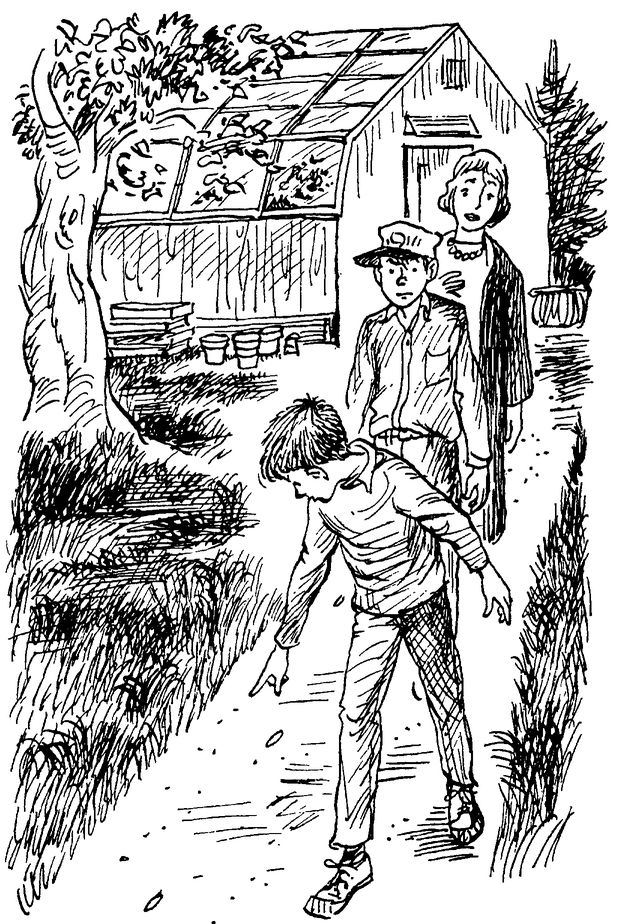Encyclopedia Brown Finds the Clues (5 page)
Read Encyclopedia Brown Finds the Clues Online
Authors: Donald J. Sobol

The Case of the Telltale Paint
One afternoon Mrs. Carleton, who owned a flower shop, called Encyclopedia by a new name.
She called him a thief.
Encyclopedia was racing his bike down Prince Street when it happened.
He had sped past Mrs. Carleton’s back yard with his head down. His eyes were on the road. He had not seen her struggling to her feet.
But she saw him whizzing off.
First her mouth opened so wide you could count her teeth. Then she started screaming as though Jesse James were getting away on a high-school horse.
“Thief! Stop, thief!”
Encyclopedia braked with all his might. He slammed to a stop like a near-sighted knight jousting the palace wall. Riding back to Mrs. Carleton, he felt his nose to see if it was bleeding.
Mrs. Carleton quieted down when she recognized Idaville’s only boy detective.
“What were you speeding from?” she demanded, still suspicious.
“I’m in a bike race,” said Encyclopedia. “It’s twice around the block to see who clocks the fastest time. So far Herb Stein is leading by seven seconds.”
“Oh,” said Mrs. Carleton. “For a moment I thought you were the one who stole my purse.”
“You were just robbed?”
“As I was getting out of my car,” she said. “Somebody sneaked up behind me, grabbed my purse, and knocked me down.”
“I didn’t pass anyone,” said Encyclopedia. “The thief must have run through one of the back yards.”
“Then he’s got clean away,” said Mrs. Carleton. “I’d better telephone for the police.”
Encyclopedia straightened. It wasn’t the moment for hiding his light.
“Excuse me,” he said. “Perhaps you could use my professional services. My fee is only twenty-five cents a day, plus expenses.”
Mrs. Carleton smiled. “All right. But your fee will have to wait till my purse is recovered.”
“Is there anyone in the house?” Encyclopedia asked. “Anyone who might have seen what happened?”
“I live alone,” said Mrs. Carleton. “Wait, Jim Krebs is somewhere around. I hired him to paint my orchid house today.”
They found Jim in the tool shed, pouring white paint from one can into another.
“Hi, Mrs. Carleton,” he said. “This can sprung a leak. So I’m putting the paint into this one.”
Encyclopedia remembered seeing Jim, a boy of thirteen, hanging around the Tigers’ clubhouse.
“Did you see who stole Mrs. Carleton’s purse just now?” asked Encyclopedia.
“No,” said Jim quickly. “I didn’t see or hear anything. I’ve been in this tool shed the past few minutes.”
“May I look around?” Encyclopedia asked Mrs. Carleton.
“Go right ahead,” Mrs. Carleton said. “Jim, please help Encyclopedia all you can.”
“Sure,” agreed Jim’s mouth. The rest of him looked as though he’d rather go over Niagara Falls on a salad plate.
Encyclopedia searched the tool shed. He even poked a stick into the can with the white paint. Satisfied that Jim had not stolen the purse and hidden it, he walked outside.
The path between the orchid house, which Jim had been painting, and the tool shed was about three hundred feet long. Drops of white paint from the leaking can had fallen in a straight line between the two small buildings.
“I was using the white paint when I noticed the leak in the bottom of the can,” said Jim. “So I walked to the tool shed with the can. Those paint drops prove it. I didn’t see or hear any thief.”

Encyclopedia looked carefully at the drops of paint.
“From any place on the path, you can see the spot where Mrs. Carleton was knocked down,” said Encyclopedia. “You
must
have seen it happen.”
must
have seen it happen.”
“I didn’t see anything,” said Jim. “Leave me alone.”
Encyclopedia went out to the path. He looked carefully at the drops of paint.
“Jim’s telling the truth,” he thought. “He couldn’t be the thief. The paint drops show that he went straight from the orchid house to the tool shed.”
Jim couldn’t have had time to steal Mrs. Carleton’s purse and run back to the tool shed, Encyclopedia realized. She would have seen him.
Then the boy sleuth noticed something strange about the drops of paint. They changed.
From the orchid house to about halfway along the path, the drops were nearly round. They had fallen about two feet apart.
But from the halfway point to the tool shed, the drops were narrow. They had fallen about eight feet apart.
“Hey, Encyclopedia! What are you doing?”
Encyclopedia looked toward the street. He saw some of the gang from the bike races—Herb Stein, Charlie Stewart, and Sally Kimball.
“Boy, we thought you’d crashed into a tree or something,” called Herb.
Encyclopedia hurried over. He explained the reason for his failure to cross the finish line.
“Do you know who stole Mrs. Carleton’s purse?” asked Sally.
“The thief got away,” said Encyclopedia. “But Jim Krebs saw the whole thing. He won’t admit it, though. I think he’s scared the thief saw him and will hurt him if he tells.”
“That’s like Jim,” said Charlie. “Bugs Meany won’t have him for a Tiger. Bugs says Jim has only one stripe, and you know what color that is.”
“He’s so yellow he makes a canary jealous,” said Herb.
“Stop being mean,” said Sally angrily.
“It’s not funny,” agreed Encyclopedia. “However, Jim’s fear did give him away. He suddenly got awfully frightened while he was carrying the leaky can of paint to the tool shed.”
HOW DID ENCYCLOPEDIA KNOW?

The Case of the Stolen Diamonds
Encyclopedia looked up from his book,
Diamonds for Everyone.
His mother stood in the doorway of his room.
Diamonds for Everyone.
His mother stood in the doorway of his room.
“Did you know that diamonds are so hard they’re used to drill stone?” he asked.
“I may need a diamond to drill my roast beef,” said his mother. “It will be cooked as hard as stone if you don’t come to dinner.”
“Sorry, Mom,” said Encyclopedia. He put the book aside, washed, and hurried to the table. He wanted to talk about diamonds.
His father, however, had a problem.
“The police chiefs from all over the state will be here next week,” said Chief Brown. “They chose Idaville for their yearly meeting.”
“Are you worried about how to keep them interested?” asked Mrs. Brown.
“Exactly,” said Chief Brown. “Every year there are speeches and more speeches. I want to do something different in Idaville.”
“Why don’t you have the chiefs solve a crime?” asked Encyclopedia.
“How can I?” asked Chief Brown. “There hasn’t been an unsolved crime in Idaville in a year. Thanks to you know who.”
“So commit a crime,” said Encyclopedia.
“Did I hear you correctly, Leroy?” asked Mrs. Brown.
“I’ve been reading about diamonds,” replied Encyclopedia. “Why not steal a diamond?”
“Mr. Van Swigget, the jeweler, has a diamond necklace,” said Chief Brown. “It’s worth fifty thousand dollars. Would you like to steal it for me?”
Encyclopedia shook his head and smiled.
“Make believe the necklace is stolen, Dad,” he said. “Give the police chiefs all the clues. Then let them try to solve the case.”
“Sort of a test, eh?” said Chief Brown thoughtfully. “By golly, you may have something there.”
Between the roast beef and the butterscotch pudding, Chief Brown decided to put on the unusual event. Encyclopedia worked out the crime before going to bed.
In the morning his father went to see Mr. Van Swigget. The jeweler agreed to play a part in the make-believe crime. In fact, he was delighted to have a chance to test the best police brains in the state.
So it was that five days later thirty chiefs of police gathered in Mr. Van Swigget’s office. Encyclopedia stood in the front of the room beside his father.
Mr. Van Swigget pretended to seem very upset.
“A diamond necklace was stolen this morning,” he said. “It is insured for fifty thousand dollars. But money can’t replace such a treasure!”
“Pardon me,” said one of the chiefs. “What is that necklace on your desk, sir?”
Mr. Van Swigget lifted a necklace from his desk for all to see.
“This,” he said, “is a copy of the stolen diamond necklace. As you can see, it is perfect in every way. Only it is made of glass. The thieves didn’t bother with it. They knew it wasn’t the real diamond necklace.”
“Do you believe then that someone in your own store had a hand in the theft?” asked a chief.
“Yes, I do,” answered Mr. Van Swigget. “The two necklaces are kept together in a safe when not on display. Had the thieves been unsure of which was the diamond necklace, they would have taken both. But they took only the real necklace.”
Near Encyclopedia, one chief whispered to another: “Someone must have told the thieves which was the real necklace.”
Mr. Van Swigget stood up. “Now, gentlemen,” he said. “Please follow me. I shall show you how it happened.”
From the office Mr. Van Swigget led the way into the hall. The floor of the hall was covered with stone. At the end of the hall was a marble staircase.
“The diamond necklace and the glass copy are kept in the safe on the second floor,” said Mr. Van Swigget. “Shortly after ten o’clock this morning, I was bringing the fake necklace down to my office. Suddenly two masked men came charging up at me.”
Mr. Van Swigget climbed the stairs. At the top he turned around. He started down, holding his hands before him. He was pretending to carry the glass necklace.
“One of the masked men grabbed the glass necklace,” went on Mr. Van Swigget. “He fingered it, cursed, and threw it to the floor. At gunpoint the pair forced me back upstairs. I had to open the safe and give them the diamond necklace.”
Mr. Van Swigget reached the bottom of the stairs.

Mr. Van Swigget pretended to carry the glass necklace.
“Gentlemen,” he said to the police chiefs. “That is what happened. Are there any questions?”
“Are you sure that it would be impossible to tell the glass necklace and diamond necklace apart?” asked a chief.
“Not at a glance,” answered Mr. Van Swigget.
Another chief asked, “Who knows about the glass copy besides yourself?”
“My store manager, Mr. Evers, and my secretary, Mrs. Zunser,” answered Mr. Van Swigget. “They can tell the two necklaces apart. But they have been with me for twenty years. I trust them completely.”
The chiefs had no further questions. Chief Brown stepped next to Mr. Van Swigget.
“In the showroom to your left you will find pencils and paper,” said Chief Brown. “I ask you to write down your solution.”
“Gosh, Dad,” said Encyclopedia as the police chiefs passed into the showroom. “Do you think we made it too easy?”
Other books
Half Lost by Sally Green
Bittersweet Chronicles: Pax by Selena Laurence
Craving Perfect by Liz Fichera
Midnight's Warrior by Grant, Donna
Bridge for Passing by Pearl S. Buck
The Other Side of Life (Book #1, Cyberpunk Elven Trilogy) by Jess C Scott
The Blackstone Chronicles by John Saul
Chess With a Dragon by David Gerrold, David Gerrold
Catch the Fallen Sparrow by Priscilla Masters
Abroad by Katie Crouch
